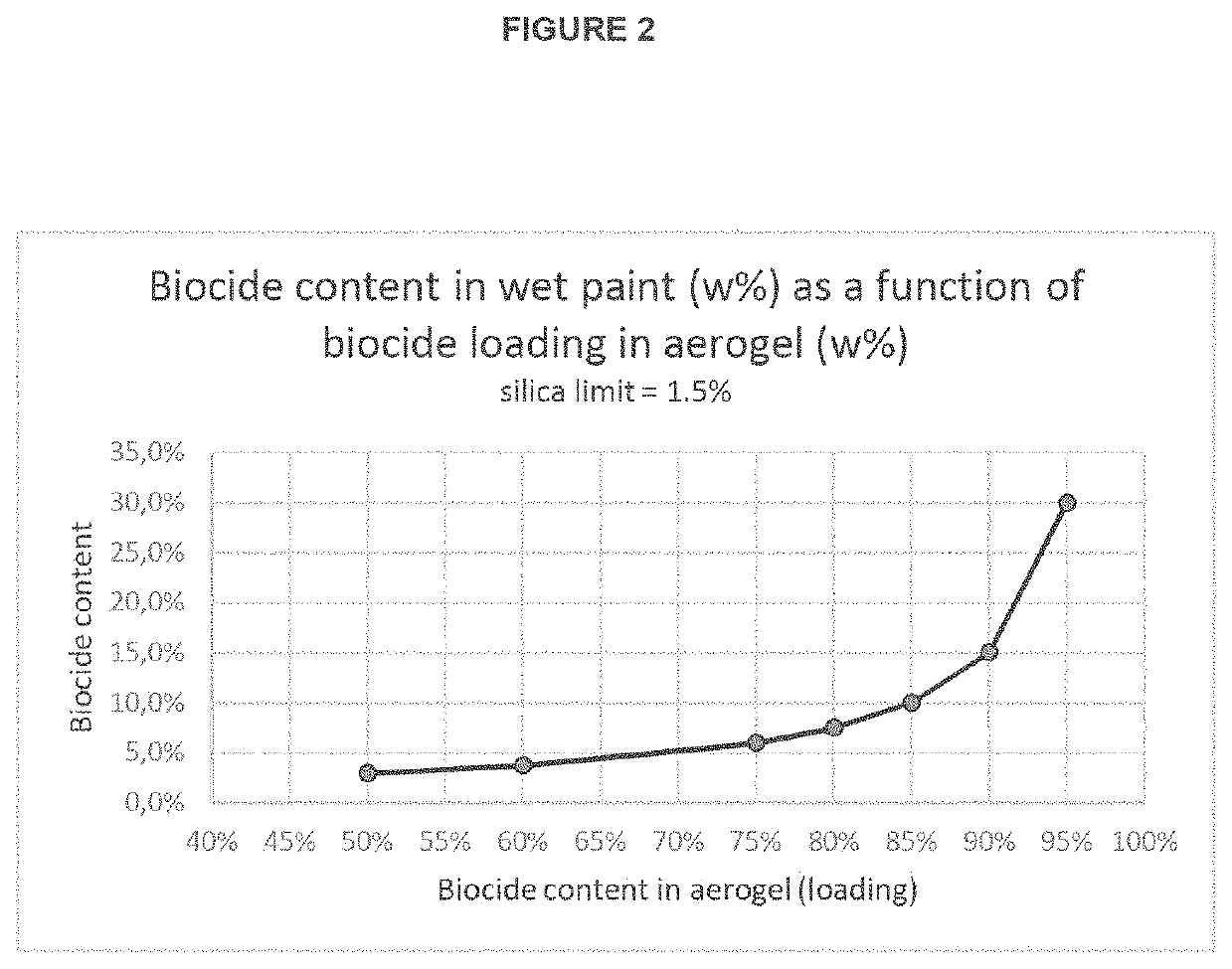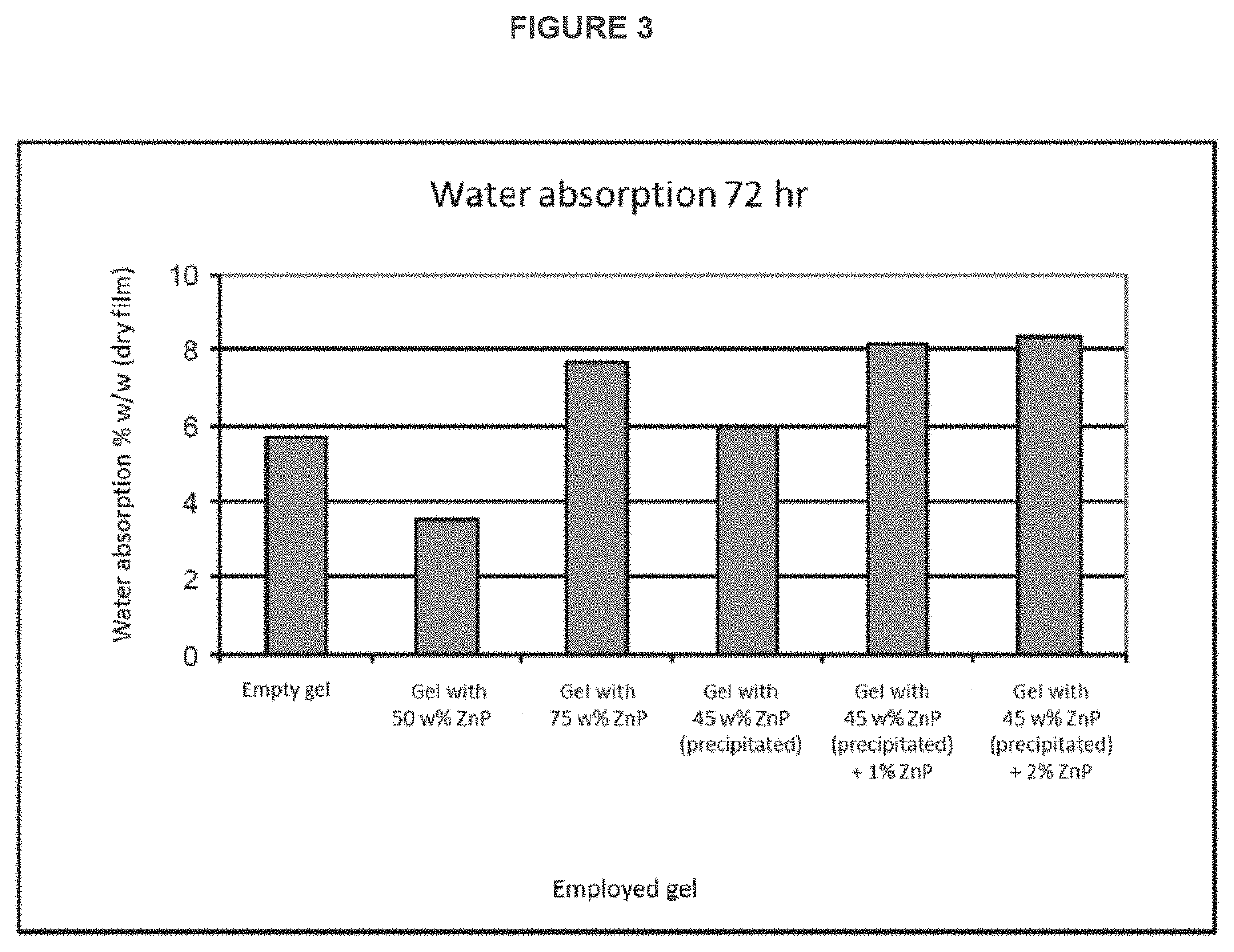Encapsulated biocides and biorepellents
a biocide and biorepellent technology, applied in the field of silicone aerogels, can solve the problems that the composition of one combination of salinity and water temperature is not necessarily ideal for another combination
- Summary
- Abstract
- Description
- Claims
- Application Information
AI Technical Summary
Benefits of technology
Problems solved by technology
Method used
Image
Examples
example 1
an Aerogel with App. 40% Encapsulated Active Compound (CuP) (Reference Example)
[0123]1. 6.9 g TMOS (Tetramethyl orthosilicate 98% from Aldrich), 3.2 g MTMS (methyltrimethoxysilane) and 40 g Ethanol was mixed on a magnetic stirrer in an Erlenmeyer flask for 15 minutes.[0124]2. 3.5 g Copper pyrithione was added slowly to 1) during mixing. The solution was mixed for additionally 15 minutes.[0125]3. 200 ml of ammonia solution (25%) was added dropwise to 2) during mixing at full speed (1500 RPM) on the magnetic stirrer. After additionally 2 minutes of mixing, the white opaque solution was transferred into a bluecap bottle. After approx. ½ hour, the gelation took place and the obtained gel was aged in methanol, for at least 24 hours at room temperature, before drying.[0126]4. The wet gel from 3) was cut into smaller pieces and transferred under ethanol to a ½ L pressure vessel (½ L flow reactor, equipped with heating jacket and metal frits in both ends). There the gel was flowed with ½ L ...
example 2
an Aerogel with App. 40% Encapsulated CuP from Pre-Condensated TMOS (Reference Example)
[0132]1. 10.5 g pre-condensated TMOS and 5.2 g MTMS was stirred on a magnetic stirrer in an Erlenmeyer flask for 15 minutes.[0133]2. 4.0 g Copper pyrithione was added slowly to 1) during mixing. The solution was mixed for additionally 15 minutes.[0134]3. 300 ml of ammonia solution (25%) was added dropwise to 2) during mixing at full speed (1500 RPM) on the magnetic stirrer. After additionally 2 minutes of mixing, the white opaque solution was transferred into a bluecap bottle. After approx. 45 minutes, the gelation took place and the obtained gel was aged in methanol, for 24 hours at room temperature, before drying.[0135]4. The wet gel from 3) was cut into smaller pieces and transferred under ethanol to a ½ L pressure vessel (½ L flow reactor, equipped with heating jacket and metal frits in both ends). There the gel was flowed with ½ L of ethanol at 0.5 mL / min. Then the temperature in the heating ...
example 2a
an Aerogel with App 80% Encapsulated Biocide (CuP)
[0136]1. Solution 1: 0.64 kg TMOS (Tetramethyl orthosilicate 98% from Aldrich), 0.32 kg MTMS (methyltrimethoxysilane), 3.2 kg Ethanol and 1.77 kg Copper pyrithione was mixed in a 10-ltr vessel and agitated vigorously with a paddle mixer.[0137]2. Solution 2: 0.64 kg Ethanol, 0.32 kg Water and 10 ml of ammonia solution (concentrated) is mixed.[0138]3. Solution 2 is added to solution 1 at identical mixing conditions as in (1) for 20-25 minutes at 125 rpm. Mixing speed is reduced until signs of gelling takes approx. 15 minutes (100 rpm). The gelling time is 30 minutes.[0139]4. The gel is stored in plastic containers for 4-5 days after which it is transferred to the extractor(s).[0140]The wet gel from 3) was cut into smaller pieces and transferred under ethanol to a 5 or 10 L pressure vessel (flow reactor, equipped with heating jacket and metal frits in both ends). There the gel was flowed with ½ L of ethanol at 0.5 mL / min. Then the tempe...
PUM
| Property | Measurement | Unit |
|---|---|---|
| bulk density | aaaaa | aaaaa |
| density | aaaaa | aaaaa |
| w/w | aaaaa | aaaaa |
Abstract
Description
Claims
Application Information
 Login to View More
Login to View More - R&D
- Intellectual Property
- Life Sciences
- Materials
- Tech Scout
- Unparalleled Data Quality
- Higher Quality Content
- 60% Fewer Hallucinations
Browse by: Latest US Patents, China's latest patents, Technical Efficacy Thesaurus, Application Domain, Technology Topic, Popular Technical Reports.
© 2025 PatSnap. All rights reserved.Legal|Privacy policy|Modern Slavery Act Transparency Statement|Sitemap|About US| Contact US: help@patsnap.com



